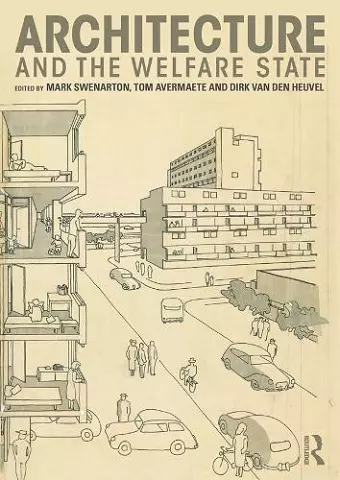Architecture and the Welfare State
Tom Avermaete editor Mark Swenarton editor Dirk van den Heuvel editor
Format:Paperback
Publisher:Taylor & Francis Ltd
Published:26th Aug '14
Currently unavailable, and unfortunately no date known when it will be back
This paperback is available in another edition too:
- Hardback£180.00(9780415725392)

In the decades following World War Two, and in part in response to the Cold War, governments across Western Europe set out ambitious programmes for social welfare and the redistribution of wealth that aimed to improve the everyday lives of their citizens. Many of these welfare state programmes - housing, schools, new towns, cultural and leisure centres – involved not just construction but a new approach to architectural design, in which the welfare objectives of these state-funded programmes were delineated and debated. The impact on architects and architectural design was profound and far-reaching, with welfare state projects moving centre-stage in architectural discourse not just in Europe but worldwide.
This is the first book to explore the architecture of the welfare state in Western Europe from an international perspective. With chapters covering Austria, Belgium, France, Germany, Italy, The Netherlands, Sweden and the UK, the book explores the complex role played by architecture in the formation and development of the welfare state in both theory and practice.
Themes include:
- the role of the built environment in the welfare state as a political project
- the colonial dimension of European welfare state architecture and its ‘export’ to Africa and Asia
- the role of welfare state projects in promoting consumer culture and economic growth
- the picture of the collective produced by welfare state architecture
- the role of architectural innovation in the welfare state
- the role of the architect, as opposed to construction companies and others, in determining what was built
- the relationship between architectural and social theory
- the role of internal institutional critique and the counterculture.
Contributors include: Tom Avermaete, Eve Blau, Nicholas Bullock, Miles Glendinning, Janina Gosseye, Hilde Heynen, Caroline Maniaque-Benton, Helena Mattsson, Luca Molinari, Simon Pepper, Michelle Provoost, Lukasz Stanek, Mark Swenarton, Florian Urban and Dirk van den Heuvel.
"Poverty and deprivation are discussed less today than in the 70s, although the wealth gap is greater and housing for the poor is worse. This book is an essential aid to understanding the international discourse between architects during the 30 golden years and the way it was shaped, enabled and constrained by socio-political and economic frameworks." – Kate Macintosh, RIBA Journal
"This book scores highly due to the high quality of its contributions. The choice and quantity of illustrations in this book must also be given praise." – Stefan Muthesius, Building Research & Information Journal, University of East Anglia, UK
"Architecture and the Welfare State represents the opening up of new and critical pathways through its territory. Its consistently high scholarship is augmented not only by an extended and thematic bibliography, but also by the appended notes (edited by Adrian Forty) of the workshop from which the book emerged." – Gary A. Boyd, The Queen’s University, The Journal of Architecture
"The book is organised around broad themes – ‘cultures and continuities’, ‘critiques and contradictions’ and ‘national and international’ – while detailing much about the experiences of several different countries in Europe and beyond. The result is a rich and stimulating mix that is scholarly, informative and thought-provoking. The editors have successfully combined a central and coherent focus with enough eclecticism to make the book useful both in its entirety and its individual parts." – Town Planning Review, Stephen V. Ward, Oxford Brookes University, UK
"Archtecture and the Welfare State is a valuable contribution - it offers nuanced scrutiny of a period when wealth redistribution by the state was a broadly accepted process in which the built environment figured prominently. It largely delivers on its underlying claim to place the architect (and architecture) more clearly as an actor within the complex social, political, cultural and technological networks." - Lee Stickells, Fabrications, the Journal of the SAHANZ (Australia and New Zealand)
ISBN: 9780415725408
Dimensions: unknown
Weight: 612g
360 pages